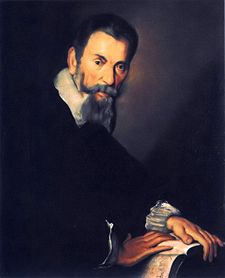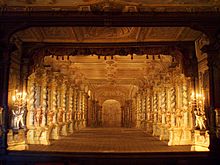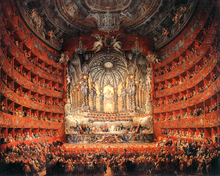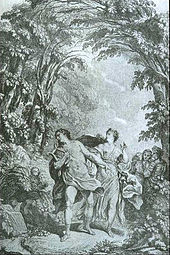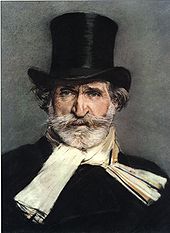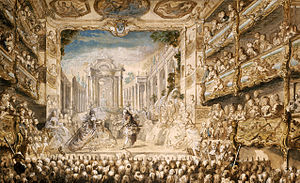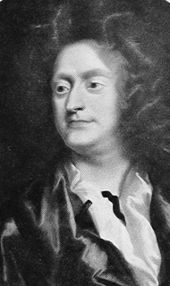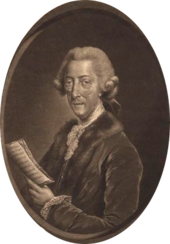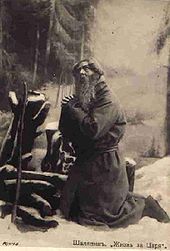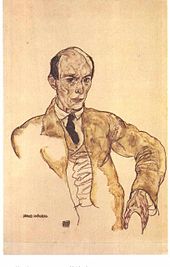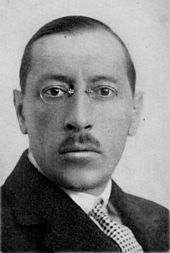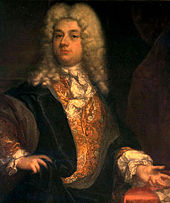
Opera
Did you know...
This wikipedia selection has been chosen by volunteers helping SOS Children from Wikipedia for this Wikipedia Selection for schools. SOS Children has looked after children in Africa for forty years. Can you help their work in Africa?
Opera (English plural: operas; Italian plural: opere) is an art form in which singers and musicians perform a dramatic work combining text (called a libretto) and musical score, usually in a theatrical setting. Opera incorporates many of the elements of spoken theatre, such as acting, scenery, and costumes and sometimes includes dance. The performance is typically given in an opera house, accompanied by an orchestra or smaller musical ensemble.
Opera is part of the Western classical music tradition. It started in Italy at the end of the 16th century (with Jacopo Peri's lost Dafne, produced in Florence in 1598) and soon spread through the rest of Europe: Schütz in Germany, Lully in France, and Purcell in England all helped to establish their national traditions in the 17th century. In the 18th century, Italian opera continued to dominate most of Europe, except France, attracting foreign composers such as Handel. Opera seria was the most prestigious form of Italian opera, until Gluck reacted against its artificiality with his "reform" operas in the 1760s. Today the most renowned figure of late 18th century opera is Mozart, who began with opera seria but is most famous for his Italian comic operas, especially The Marriage of Figaro (Le Nozze Di Figaro), Don Giovanni, and Così fan tutte, as well as The Magic Flute (Die Zauberflöte), a landmark in the German tradition.
The first third of the 19th century saw the highpoint of the bel canto style, with Rossini, Donizetti and Bellini all creating works that are still performed today. It also saw the advent of Grand Opera typified by the works of Auber and Meyerbeer. The mid-to-late 19th century was a "golden age" of opera, led and dominated by Wagner in Germany and Verdi in Italy. The popularity of opera continued through the verismo era in Italy and contemporary French opera through to Puccini and Strauss in the early 20th century. During the 19th century, parallel operatic traditions emerged in central and eastern Europe, particularly in Russia and Bohemia. The 20th century saw many experiments with modern styles, such as atonality and serialism ( Schoenberg and Berg), Neoclassicism (Stravinsky), and Minimalism ( Philip Glass and John Adams). With the rise of recording technology, singers such as Enrico Caruso became known to audiences beyond the circle of opera fans. Operas were also performed on (and written for) radio and television.
Operatic terminology
The words of an opera are known as the libretto (literally "little book"). Some composers, notably Richard Wagner, have written their own libretti; others have worked in close collaboration with their librettists, e.g. Mozart with Lorenzo Da Ponte. Traditional opera, often referred to as " number opera", consists of two modes of singing: recitative, the plot-driving passages sung in a style designed to imitate and emphasize the inflections of speech, and aria (an "air" or formal song) in which the characters express their emotions in a more structured melodic style. Duets, trios and other ensembles often occur, and choruses are used to comment on the action. In some forms of opera, such as Singspiel, opéra comique, operetta, and semi-opera, the recitative is mostly replaced by spoken dialogue. Melodic or semi-melodic passages occurring in the midst of, or instead of, recitative, are also referred to as arioso. During the Baroque and Classical periods, recitative could appear in two basic forms: secco (dry) recitative, sung with a free rhythm dictated by the accent of the words, accompanied only by continuo, which was usually a harpsichord and a cello; or accompagnato (also known as strumentato) in which the orchestra provided accompaniment. By the 19th century, accompagnato had gained the upper hand, the orchestra played a much bigger role, and Richard Wagner revolutionised opera by abolishing almost all distinction between aria and recitative in his quest for what he termed "endless melody". Subsequent composers have tended to follow Wagner's example, though some, such as Stravinsky in his The Rake's Progress have bucked the trend. The terminology of the various kinds of operatic voices is described in detail below.
History
Origins
The word opera means "work" in Italian (it is the plural of Latin opus meaning "work" or "labour") suggesting that it combines the arts of solo and choral singing, declamation, acting and dancing in a staged spectacle. Dafne by Jacopo Peri was the earliest composition considered opera, as understood today. It was written around 1597, largely under the inspiration of an elite circle of literate Florentine humanists who gathered as the " Camerata de' Bardi". Significantly, Dafne was an attempt to revive the classical Greek drama, part of the wider revival of antiquity characteristic of the Renaissance. The members of the Camerata considered that the "chorus" parts of Greek dramas were originally sung, and possibly even the entire text of all roles; opera was thus conceived as a way of "restoring" this situation. Dafne is unfortunately lost. A later work by Peri, Euridice, dating from 1600, is the first opera score to have survived to the present day. The honour of being the first opera still to be regularly performed, however, goes to Claudio Monteverdi's L'Orfeo, composed for the court of Mantua in 1607. The Mantua court of the Gonzagas, employers of Monteverdi, played a significant role in the origin of opera employing not only court singers of the concerto delle donne (till 1598), but also one of the first actual "opera singers"; Madama Europa.
Italian opera
The Baroque era
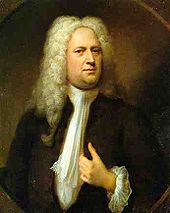
Opera did not remain confined to court audiences for long. In 1637, the idea of a "season" ( Carnival) of publicly attended operas supported by ticket sales emerged in Venice. Monteverdi had moved to the city from Mantua and composed his last operas, Il ritorno d'Ulisse in patria and L'incoronazione di Poppea, for the Venetian theatre in the 1640s. His most important follower Francesco Cavalli helped spread opera throughout Italy. In these early Baroque operas, broad comedy was blended with tragic elements in a mix that jarred some educated sensibilities, sparking the first of opera's many reform movements, sponsored by Venice's Arcadian Academy which came to be associated with the poet Metastasio, whose libretti helped crystallize the genre of opera seria, which became the leading form of Italian opera until the end of the 18th century. Once the Metastasian ideal had been firmly established, comedy in Baroque-era opera was reserved for what came to be called opera buffa.
Before such elements were forced out of opera seria, many libretti had featured a separately unfolding comic plot as sort of an "opera-within-an-opera." One reason for this was an attempt to attract members of the growing merchant class, newly wealthy, but still less cultured than the nobility, to the public opera houses. These separate plots were almost immediately resurrected in a separately developing tradition that partly derived from the commedia dell'arte, a long-flourishing improvisatory stage tradition of Italy. Just as intermedi had once been performed in-between the acts of stage plays, operas in the new comic genre of "intermezzi", which developed largely in Naples in the 1710s and '20s, were initially staged during the intermissions of opera seria. They became so popular, however, that they were soon being offered as separate productions.
Opera seria was elevated in tone and highly stylised in form, usually consisting of secco recitative interspersed with long da capo arias. These afforded great opportunity for virtuosic singing and during the golden age of opera seria the singer really became the star. The role of the hero was usually written for the castrato voice; castrati such as Farinelli and Senesino, as well as female sopranos such as Faustina Bordoni, became in great demand throughout Europe as opera seria ruled the stage in every country except France. Indeed, Farinelli was one of the most famous singers of the 18th century. Italian opera set the Baroque standard. Italian libretti were the norm, even when a German composer like Handel found himself composing the likes of Rinaldo and Giulio Cesare for London audiences. Italian libretti remained dominant in the classical period as well, for example in the operas of Mozart, who wrote in Vienna near the century's close. Leading Italian-born composers of opera seria include Alessandro Scarlatti, Vivaldi and Porpora.
Reform: Gluck, the attack on the Metastasian ideal, and Mozart
|
Mozart K. 527
Overture to Don Giovanni (1787), one of Mozart's most well-known pieces. (6:49 minutes)
|
Opera seria had its weaknesses and critics. The taste for embellishment on behalf of the superbly trained singers, and the use of spectacle as a replacement for dramatic purity and unity drew attacks. Francesco Algarotti's Essay on the Opera (1755) proved to be an inspiration for Christoph Willibald Gluck's reforms. He advocated that opera seria had to return to basics and that all the various elements—music (both instrumental and vocal), ballet, and staging—must be subservient to the overriding drama. Several composers of the period, including Niccolò Jommelli and Tommaso Traetta, attempted to put these ideals into practice. The first to succeed however, was Gluck. Gluck strove to achieve a "beautiful simplicity". This is evident in his first reform opera, Orfeo ed Euridice, where his non-virtuosic vocal melodies are supported by simple harmonies and a richer orchestra presence throughout.
Gluck's reforms have had resonance throughout operatic history. Weber, Mozart and Wagner, in particular, were influenced by his ideals. Mozart, in many ways Gluck's successor, combined a superb sense of drama, harmony, melody, and counterpoint to write a series of comedies, notably Così fan tutte, The Marriage of Figaro, and Don Giovanni (in collaboration with Lorenzo Da Ponte) which remain among the most-loved, popular and well-known operas today. But Mozart's contribution to opera seria was more mixed; by his time it was dying away, and in spite of such fine works as Idomeneo and La clemenza di Tito, he would not succeed in bringing the art form back to life again.
Bel canto, Verdi and verismo
|
No Pagliaccio non son
Aria from Ruggero Leoncavallo's Pagliacci. Performed by Enrico Caruso
|
The bel canto opera movement flourished in the early 19th century and is exemplified by the operas of Rossini, Bellini, Donizetti, Pacini, Mercadante and many others. Literally "beautiful singing", bel canto opera derives from the Italian stylistic singing school of the same name. Bel canto lines are typically florid and intricate, requiring supreme agility and pitch control. Examples of famous operas in the bel canto style include Rossini's Il barbiere di Siviglia and La Cenerentola, as well as Donizetti's Lucia di Lammermoor.
Following the bel canto era, a more direct, forceful style was rapidly popularized by Giuseppe Verdi, beginning with his biblical opera Nabucco. Verdi's operas resonated with the growing spirit of Italian nationalism in the post-Napoleonic era, and he quickly became an icon of the patriotic movement (although his own politics were perhaps not quite so radical). In the early 1850s, Verdi produced his three most popular operas: Rigoletto, Il trovatore and La traviata. But he continued to develop his style, composing perhaps the greatest French Grand Opera, Don Carlos, and ending his career with two Shakespeare-inspired works, Otello and Falstaff, which reveal how far Italian opera had grown in sophistication since the early 19th century.
After Verdi, the sentimental "realistic" melodrama of verismo appeared in Italy. This was a style introduced by Pietro Mascagni's Cavalleria rusticana and Ruggero Leoncavallo's Pagliacci that came virtually to dominate the world's opera stages with such popular works as Giacomo Puccini's La bohème, Tosca, and Madama Butterfly. Later Italian composers, such as Berio and Nono, have experimented with modernism.
German-language opera
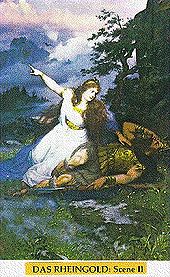
The first German opera was Dafne, composed by Heinrich Schütz in 1627, but the music score has not survived. Italian opera held a great sway over German-speaking countries until the late 18th century. Nevertheless, native forms developed too. In 1644 Sigmund Staden produced the first Singspiel, Seelewig, a popular form of German-language opera in which singing alternates with spoken dialogue. In the late 17th century and early 18th century, the Theatre am Gänsemarkt in Hamburg presented German operas by Keiser, Telemann and Handel. Yet most of the major German composers of the time, including Handel himself, as well as Graun, Hasse and later Gluck, chose to write most of their operas in foreign languages, especially Italian. In contrast to Italian opera, which was generally composed for the aristocratic class, German opera was generally composed for the masses and tended to feature simple folk-like melodies, and it was not until the arrival of Mozart that German opera was able to match its Italian counterpart in musical sophistication.
Mozart's Singspiele, Die Entführung aus dem Serail (1782) and Die Zauberflöte (1791) were an important breakthrough in achieving international recognition for German opera. The tradition was developed in the 19th century by Beethoven with his Fidelio, inspired by the climate of the French Revolution. Carl Maria von Weber established German Romantic opera in opposition to the dominance of Italian bel canto. His Der Freischütz (1821) shows his genius for creating a supernatural atmosphere. Other opera composers of the time include Marschner, Schubert and Lortzing, but the most significant figure was undoubtedly Wagner.
Wagner was one of the most revolutionary and controversial composers in musical history. Starting under the influence of Weber and Meyerbeer, he gradually evolved a new concept of opera as a Gesamtkunstwerk (a "complete work of art"), a fusion of music, poetry and painting. He greatly increased the role and power of the orchestra, creating scores with a complex web of leitmotifs, recurring themes often associated with the characters and concepts of the drama, of which prototypes can be heard in his earlier operas such as Der fliegende Holländer, Tannhäuser and Lohengrin; and he was prepared to violate accepted musical conventions, such as tonality, in his quest for greater expressivity. In his mature music dramas, Tristan und Isolde, Die Meistersinger von Nürnberg, Der Ring des Nibelungen and Parsifal, he abolished the distinction between aria and recitative in favour of a seamless flow of "endless melody". Wagner also brought a new philosophical dimension to opera in his works, which were usually based on stories from Germanic or Arthurian legend. Finally, Wagner built his own opera house at Bayreuth with part of the patronage from Ludwig II of Bavaria, exclusively dedicated to performing his own works in the style he wanted.
Opera would never be the same after Wagner and for many composers his legacy proved a heavy burden. On the other hand, Richard Strauss accepted Wagnerian ideas but took them in wholly new directions. He first won fame with the scandalous Salome and the dark tragedy Elektra, in which tonality was pushed to the limits. Then Strauss changed tack in his greatest success, Der Rosenkavalier, where Mozart and Viennese waltzes became as important an influence as Wagner. Strauss continued to produce a highly varied body of operatic works, often with libretti by the poet Hugo von Hofmannsthal. Other composers who made individual contributions to German opera in the early 20th century include Alexander von Zemlinsky, Erich Korngold, Franz Schreker, Paul Hindemith, Kurt Weill and the Italian-born Ferruccio Busoni. The operatic innovations of Arnold Schoenberg and his successors are discussed in the section on modernism.
During the late 19th century, the Austrian composer Johann Strauss II, an admirer of the French-language operettas composed by Jacques Offenbach, composed several German-language operettas, the most famous of which was Die Fledermaus, which is still regularly performed today. Nevertheless, rather than copying the style of Offenbach, the operettas of Strauss II had distinctly Viennese flavour to them, which have cemented the Strauss II's place as one of the most renowned operetta composers of all time.
French opera
In rivalry with imported Italian opera productions, a separate French tradition was founded by the Italian Jean-Baptiste Lully at the court of King Louis XIV. Despite his foreign origin, Lully established an Academy of Music and monopolised French opera from 1672. Starting with Cadmus et Hermione, Lully and his librettist Quinault created tragédie en musique, a form in which dance music and choral writing were particularly prominent. Lully's operas also show a concern for expressive recitative which matched the contours of the French language. In the 18th century, Lully's most important successor was Jean-Philippe Rameau, who composed five tragédies en musique as well as numerous works in other genres such as opéra-ballet, all notable for their rich orchestration and harmonic daring. Despite the popularity of Italian opera seria throughout much of Europe during the Baroque period, Italian opera never gained much of a foothold in France, where its own national operatic tradition was more popular instead. After Rameau's death, the German Gluck was persuaded to produce six operas for the Parisian stage in the 1770s. They show the influence of Rameau, but simplified and with greater focus on the drama. At the same time, by the middle of the 18th century another genre was gaining popularity in France: opéra comique. This was the equivalent of the German singspiel, where arias alternated with spoken dialogue. Notable examples in this style were produced by Monsigny, Philidor and, above all, Grétry. During the Revolutionary period, composers such as Méhul and Cherubini, who were followers of Gluck, brought a new seriousness to the genre, which had never been wholly "comic" in any case. Another phenomenon of this period was the 'propaganda opera' celebrating revolutionary successes, e.g. Gossec's Le triomphe de la République (1793).
By the 1820s, Gluckian influence in France had given way to a taste for Italian bel canto, especially after the arrival of Rossini in Paris. Rossini's Guillaume Tell helped found the new genre of Grand Opera, a form whose most famous exponent was another foreigner, Giacomo Meyerbeer. Meyerbeer's works, such as Les Huguenots emphasised virtuoso singing and extraordinary stage effects. Lighter opéra comique also enjoyed tremendous success in the hands of Boïeldieu, Auber, Hérold and Adolphe Adam. In this climate, the operas of the French-born composer Hector Berlioz struggled to gain a hearing. Berlioz's epic masterpiece Les Troyens, the culmination of the Gluckian tradition, was not given a full performance for almost a hundred years.
|
Carmen: Chanson du toréador
Pasquale Amato's 1911 rendition of the Toréador's song from Georges Bizet's Carmen (1875).
|
In the second half of the 19th century, Jacques Offenbach created operetta with witty and cynical works such as Orphée aux enfers, as well as the opera Les Contes d'Hoffmann; Charles Gounod scored a massive success with Faust; and Bizet composed Carmen, which, once audiences learned to accept its blend of Romanticism and realism, became the most popular of all opéra comiques. Jules Massenet, Camille Saint-Saëns and Léo Delibes all composed works which are still part of the standard repertory, examples being Massenet's Manon, Saint-Saëns' Samson et Dalila and Delibes' Lakmé. At the same time, the influence of Richard Wagner was felt as a challenge to the French tradition. Many French critics angrily rejected Wagner's music dramas while many French composers closely imitated them with variable success. Perhaps the most interesting response came from Claude Debussy. As in Wagner's works, the orchestra plays a leading role in Debussy's unique opera Pelléas et Mélisande (1902) and there are no real arias, only recitative. But the drama is understated, enigmatic and completely unWagnerian.
Other notable 20th century names include Ravel, Dukas, Roussel and Milhaud. Francis Poulenc is one of the very few post-war composers of any nationality whose operas (which include Dialogues des Carmélites) have gained a foothold in the international repertory. Olivier Messiaen's lengthy sacred drama Saint François d'Assise (1983) has also attracted widespread attention.
English-language opera
|
Stay, Prince and hear
A scene from Purcell's Dido and Æneas. The witches' messenger, in the form of Mercury himself, attempts to convince Æneas to leave Carthage.
|
In England, opera's antecedent was the 17th century jig. This was an afterpiece which came at the end of a play. It was frequently libellous and scandalous and consisted in the main of dialogue set to music arranged from popular tunes. In this respect, jigs anticipate the ballad operas of the 18th century. At the same time, the French masque was gaining a firm hold at the English Court, with even more lavish splendour and highly realistic scenery than had been seen before. Inigo Jones became the quintessential designer of these productions, and this style was to dominate the English stage for three centuries. These masques contained songs and dances. In Ben Jonson's Lovers Made Men (1617), "the whole masque was sung after the Italian manner, stilo recitativo". The approach of the English Commonwealth closed theatres and halted any developments that may have led to the establishment of English opera. However, in 1656, the dramatist Sir William Davenant produced The Siege of Rhodes. Since his theatre was not licensed to produce drama, he asked several of the leading composers (Lawes, Cooke, Locke, Coleman and Hudson) to set sections of it to music. This success was followed by The Cruelty of the Spaniards in Peru (1658) and The History of Sir Francis Drake (1659). These pieces were encouraged by Oliver Cromwell because they were critical of Spain. With the English Restoration, foreign (especially French) musicians were welcomed back. In 1673, Thomas Shadwell's Psyche, patterned on the 1671 'comédie-ballet' of the same name produced by Molière and Jean-Baptiste Lully. William Davenant produced The Tempest in the same year, which was the first musical adaption of a Shakespeare play (composed by Locke and Johnson). About 1683, John Blow composed Venus and Adonis, often thought of as the first true English-language opera.
Blow's immediate successor was the better known Henry Purcell. Despite the success of his masterwork Dido and Aeneas (1689), in which the action is furthered by the use of Italian-style recitative, much of Purcell's best work was not involved in the composing of typical opera, but instead he usually worked within the constraints of the semi-opera format, where isolated scenes and masques are contained within the structure of a spoken play, such as Shakespeare in Purcell's The Fairy-Queen (1692) and Beaumont and Fletcher in The Prophetess (1690) and Bonduca (1696). The main characters of the play tend not to be involved in the musical scenes, which means that Purcell was rarely able to develop his characters through song. Despite these hindrances, his aim (and that of his collaborator John Dryden) was to establish serious opera in England, but these hopes ended with Purcell's early death at the age of 36.
Following Purcell, the popularity of opera in England dwindled for several decades. A revived interest in opera occurred in the 1730s which is largely attributed to Thomas Arne, both for his own compositions and for alerting Handel to the commercial possibilities of large-scale works in English. Arne was the first English composer to experiment with Italian-style all-sung comic opera, with his greatest success being Thomas and Sally in 1760. His opera Artaxerxes (1762) was the first attempt to set a full-blown opera seria in English and was a huge success, holding the stage until the 1830s. Although Arne imitated many elements of Italian opera, he was perhaps the only English composer at that time who was able to move beyond the Italian influences and create his own unique and distinctly English voice. His modernized ballad opera, Love in a Village (1762), began a vogue for pastiche opera that lasted well into the 19th century. Charles Burney wrote that Arne introduced "a light, airy, original, and pleasing melody, wholly different from that of Purcell or Handel, whom all English composers had either pillaged or imitated".
Besides Arne, the other dominating force in English opera at this time was George Frideric Handel, whose opera serias filled the London operatic stages for decades, and influenced most home-grown composers, like John Frederick Lampe, who wrote using Italian models. This situation continued throughout the 18th and 19th centuries, including in the work of Michael William Balfe, and the operas of the great Italian composers, as well as those of Mozart, Beethoven and Meyerbeer, continued to dominate the musical stage in England.
The only exceptions were ballad operas, such as John Gay's The Beggar's Opera (1728), musical burlesques, European operettas, and late Victorian era light operas, notably the Savoy Operas of W. S. Gilbert and Arthur Sullivan, all of which types of musical entertainments frequently spoofed operatic conventions. Sullivan wrote only one grand opera, Ivanhoe (following the efforts of a number of young English composers beginning about 1876), but he claimed that even his light operas constituted part of a school of "English" opera, intended to supplant the French operettas (usually performed in bad translations) that had dominated the London stage from the mid-19th century into the 1870s. London's Daily Telegraph agreed, describing The Yeomen of the Guard as "a genuine English opera, forerunner of many others, let us hope, and possibly significant of an advance towards a national lyric stage."
In the 20th century, English opera began to assert more independence, with works of Ralph Vaughan Williams and in particular Benjamin Britten, who in a series of works that remain in standard repertory today, revealed an excellent flair for the dramatic and superb musicality. Today composers such as Thomas Adès continue to export English opera abroad. More recently Sir Harrison Birtwistle has emerged as one of Britain's most significant contemporary composers from his first opera Punch and Judy to his most recent critical success in The Minotaur. In the first decade of the 21st century, the librettist of an early Birtwistle opera, Michael Nyman, has been focusing on composing operas, including Facing Goya, Man and Boy: Dada, and Love Counts.
Also in the 20th century, American composers like Leonard Bernstein, George Gershwin, Gian Carlo Menotti, Douglas Moore, and Carlisle Floyd began to contribute English-language operas infused with touches of popular musical styles. They were followed by composers such as Philip Glass, Mark Adamo, John Corigliano, Robert Moran, John Coolidge Adams, André Previn and Jake Heggie.
Russian opera
Opera was brought to Russia in the 1730s by the Italian operatic troupes and soon it became an important part of entertainment for the Russian Imperial Court and aristocracy. Many foreign composers such as Baldassare Galuppi, Giovanni Paisiello, Giuseppe Sarti, and Domenico Cimarosa (as well as various others) were invited to Russia to compose new operas, mostly in the Italian language. Simultaneously some domestic musicians like Maksym Berezovsky and Dmitry Bortniansky were sent abroad to learn to write operas. The first opera written in Russian was Tsefal i Prokris by the Italian composer Francesco Araja (1755). The development of Russian-language opera was supported by the Russian composers Vasily Pashkevich, Yevstigney Fomin and Alexey Verstovsky.
However, the real birth of Russian opera came with Mikhail Glinka and his two great operas A Life for the Tsar (1836) and Ruslan and Lyudmila (1842). After him in the 19th century in Russia there were written such operatic masterpieces as Rusalka and The Stone Guest by Alexander Dargomyzhsky, Boris Godunov and Khovanshchina by Modest Mussorgsky, Prince Igor by Alexander Borodin, Eugene Onegin and The Queen of Spades by Pyotr Tchaikovsky, and The Snow Maiden and Sadko by Nikolai Rimsky-Korsakov. These developments mirrored the growth of Russian nationalism across the artistic spectrum, as part of the more general Slavophilism movement.
In the 20th century the traditions of Russian opera were developed by many composers including Sergei Rachmaninoff in his works The Miserly Knight and Francesca da Rimini, Igor Stravinsky in Le Rossignol, Mavra, Oedipus rex, and The Rake's Progress, Sergei Prokofiev in The Gambler, The Love for Three Oranges, The Fiery Angel, Betrothal in a Monastery, and War and Peace; as well as Dmitri Shostakovich in The Nose and Lady Macbeth of the Mtsensk District, Edison Denisov in L'écume des jours, and Alfred Schnittke in Life with an Idiot and Historia von D. Johann Fausten.
Other national operas
Spain also produced its own distinctive form of opera, known as zarzuela, which had two separate flowerings: one from the mid-17th century through the mid-18th century, and another beginning around 1850. During the late 18th century up until the mid-19th century, Italian opera was immensely popular in Spain, supplanting the native form.
Czech composers also developed a thriving national opera movement of their own in the 19th century, starting with Bedřich Smetana, who wrote eight operas including the internationally popular The Bartered Bride. Antonín Dvořák, most famous for Rusalka, wrote 13 operas; and Leoš Janáček gained international recognition in the 20th century for his innovative works including Jenůfa, The Cunning Little Vixen, and Káťa Kabanová.
The key figure of Hungarian national opera in the 19th century was Ferenc Erkel, whose works mostly dealt with historical themes. Among his most often performed operas are Hunyadi László and Bánk bán. The most famous modern Hungarian opera is Béla Bartók's Duke Bluebeard's Castle.
Stanisław Moniuszko's opera Straszny Dwór (in English The Haunted Manor) (1861-4) represents a nineteenth century peak of Polish national opera. In the 20th century, other operas created by Polish composers included King Roger by Karol Szymanowski and Ubu Rex by Krzysztof Penderecki.
Early operas from the Caucasus region include Leyli and Majnun (1908) and Koroğlu (1937) by the Azerbaijani composer Uzeyir Hajibeyov and Absalom and Eteri (1913–1919) by the Georgian Zakaria Paliashvili.
The first Kyrgyz opera, Ai-Churek, premiered in Moscow at the Bolshoi Theatre on 26 May 1939, during Kyrgyz Art Decade. It was composed by Vladimir Vlasov, Abdylas Maldybaev and Vladimir Fere. The libretto was written by Joomart Bokonbaev, Jusup Turusbekov, and Kybanychbek Malikov. The opera is based on the Kyrgyz heroic epic Manas.
Contemporary, recent, and modernist trends
Modernism
Perhaps the most obvious stylistic manifestation of modernism in opera is the development of atonality. The move away from traditional tonality in opera had begun with Richard Wagner, and in particular the Tristan chord. Composers such as Richard Strauss, Claude Debussy, Giacomo Puccini, Paul Hindemith, Benjamin Britten and Hans Pfitzner pushed Wagnerian harmony further with a more extreme use of chromaticism and greater use of dissonance.
Operatic modernism truly began in the operas of two Viennese composers, Arnold Schoenberg and his student Alban Berg, both composers and advocates of atonality and its later development (as worked out by Schoenberg), dodecaphony. Schoenberg's early musico-dramatic works, Erwartung (1909, premiered in 1924) and Die glückliche Hand display heavy use of chromatic harmony and dissonance in general. Schoenberg also occasionally used Sprechstimme.
The two operas of Schoenberg's pupil Alban Berg, Wozzeck (1925) and Lulu (incomplete at his death in 1935) share many of the same characteristics as described above, though Berg combined his highly personal interpretation of Schoenberg's twelve-tone technique with melodic passages of a more traditionally tonal nature (quite Mahlerian in character) which perhaps partially explains why his operas have remained in standard repertory, despite their controversial music and plots. Schoenberg's theories have influenced (either directly or indirectly) significant numbers of opera composers ever since, even if they themselves did not compose using his techniques.
Composers thus influenced include the Englishman Benjamin Britten, the German Hans Werner Henze, and the Russian Dmitri Shostakovich. ( Philip Glass also makes use of atonality, though his style is generally described as minimalist, usually thought of as another 20th century development.)
However, operatic modernism's use of atonality also sparked a backlash in the form of neoclassicism. An early leader of this movement was Ferruccio Busoni, who in 1913 wrote the libretto for his neoclassical number opera Arlecchino (first performed in 1917). Also among the vanguard was the Russian Igor Stravinsky. After composing music for the Diaghilev-produced ballets Petrushka (1911) and The Rite of Spring (1913), Stravinsky turned to neoclassicism, a development culminating in his opera-oratorio Oedipus Rex (1927). Well after his Rimsky-Korsakov-inspired works The Nightingale (1914), and Mavra (1922), Stravinsky continued to ignore serialist technique and eventually wrote a full-fledged 18th century-style diatonic number opera The Rake's Progress (1951). His resistance to serialism (an attitude he reversed following Schoenberg's death) proved to be an inspiration for many other composers.
Other trends
A common trend throughout the 20th century, in both opera and general orchestral repertoire, is the use of smaller orchestras as a cost-cutting measure; the grand Romantic-era orchestras with huge string sections, multiple harps, extra horns, and exotic percussion instruments were no longer feasible. As government and private patronage of the arts decreased throughout the 20th century, new works were often commissioned and performed with smaller budgets, very often resulting in chamber-sized works, and short, one-act operas. Many of Benjamin Britten's operas are scored for as few as 13 instrumentalists; Mark Adamo's two-act realization of Little Women is scored for 18 instrumentalists.
Another feature of late 20th century opera is the emergence of contemporary historical operas, in contrast to the tradition of basing operas on more distant history, the re-telling of contemporary fictional stories or plays, or on myth or legend. The Death of Klinghoffer, Nixon in China and Doctor Atomic by John Adams, Dead Man Walking by Jake Heggie, and Anna Nicole by Mark-Anthony Turnage exemplify the dramatisation on stage of events in recent living memory, where characters portrayed in the opera were alive at the time of the premiere performance.
The Metropolitan Opera in the US reports that the average age of its audience is now 60. Many opera companies have experienced a similar trend, and opera company websites are replete with attempts to attract a younger audience. This trend is part of the larger trend of greying audiences for classical music since the last decades of the 20th century. In an effort to attract younger audiences, the Metropolitan Opera offers a student discount on ticket purchases. Major opera companies have been better able to weather the funding cutbacks, because they can afford to hire star singers which draw substantial audiences.
Smaller companies in the US have a more fragile existence, and they usually depend on a "patchwork quilt" of support from state and local governments, local businesses, and fundraisers. Nevertheless, some smaller companies have found ways of drawing new audiences. Opera Carolina offer discounts and happy hour events to the 21- to 40-year-old demographic. In addition to radio and television broadcasts of opera performances, which have had some success in gaining new audiences, broadcasts of live performances in HD to movie theatres have shown the potential to reach new audiences. Since 2006, the Met has broadcast live performances to several hundred movie screens all over the world.
From musicals back towards opera
By the late 1930s, some musicals began to be written with a more operatic structure. These works include complex polyphonic ensembles and reflect musical developments of their times. Porgy and Bess (1935), influenced by jazz styles, and Candide (1956), with its sweeping, lyrical passages and farcical parodies of opera, both opened on Broadway but became accepted as part of the opera repertory. Show Boat, West Side Story, Brigadoon, Sweeney Todd, Evita, The Light in the Piazza, The Phantom of the Opera and others tell dramatic stories through complex music and are now sometimes seen in opera houses. The Most Happy Fella (1952) is quasi-operatic and has been revived by the New York City Opera. Some musicals, such as Tommy (1969) and Jesus Christ Superstar (1971), Les Misérables (1980), Rent (1996) and Spring Awakening (2006), employ various operatic conventions, such as through composition, recitative instead of dialogue, and leitmotifs.
Acoustic enhancement in opera
A subtle type of sound electronic reinforcement called acoustic enhancement is used in some modern concert halls and theatres where operas are performed. Although none of the major opera houses "...use traditional, Broadway-style sound reinforcement, in which most if not all singers are equipped with radio microphones mixed to a series of unsightly loudspeakers scattered throughout the theatre", many use a sound reinforcement system for acoustic enhancement, and for subtle boosting of offstage voices, child singers, onstage dialogue, and sound effects (e.g., church bells in Tosca or thunder effects in Wagnerian operas).
Operatic voices
Operatic vocal technique evolved, in a time before electronic amplification, to allow singers to produce enough volume to be heard over an orchestra, without the instrumentalists having to substantially compromise their volume.
Vocal classifications
Singers and the roles they play are classified by voice type, based on the tessitura, agility, power and timbre of their voices. Male singers can be classified by vocal range as bass, bass-baritone, baritone, tenor and countertenor, and female singers as contralto, mezzo-soprano and soprano. (Men sometimes sing in the "female" vocal ranges, in which case they are termed sopranist or countertenor. The countertenor is commonly encountered in opera, sometimes singing parts written for castrati – men neutered at a young age specifically to give them a higher singing range.) Singers are then further classified by size – for instance, a soprano can be described as a lyric soprano, coloratura, soubrette, spinto, or dramatic soprano. These terms, although not fully describing a singing voice, associate the singer's voice with the roles most suitable to the singer's vocal characteristics.
Yet another sub-classification can be made according to acting skills or requirements, for example the Basso Buffo who often must be a specialist in patter as well as a comic actor. This is carried out in detail in the Fach system of German speaking countries, where historically opera and spoken drama were often put on by the same repertory company.
A particular singer's voice may change drastically over his or her lifetime, rarely reaching vocal maturity until the third decade, and sometimes not until middle age. Two French voice types, premiere dugazon and deuxieme dugazon, were named after successive stages in the career of Louise-Rosalie Lefebvre (Mme. Dugazon). Other terms originating in the star casting system of the Parisian theatres are baryton-martin and falcon.
Historical use of voice parts
The soprano voice has typically been used as the voice of choice for the female protagonist of the opera since the latter half of the 18th century. Earlier, it was common for that part to be sung by any female voice, or even a castrato. The current emphasis on a wide vocal range was primarily an invention of the Classical period. Before that, the vocal virtuosity, not range, was the priority, with soprano parts rarely extending above a high A (Handel, for example, only wrote one role extending to a high C), though the castrato Farinelli was alleged to possess a top D (his lower range was also extraordinary, extending to tenor C). The mezzo-soprano, a term of comparatively recent origin, also has a large repertoire, ranging from the female lead in Purcell's Dido and Aeneas to such heavyweight roles as Brangäne in Wagner's Tristan und Isolde (these are both roles sometimes sung by sopranos; there is quite a lot of movement between these two voice-types). For the true contralto, the range of parts is more limited, which has given rise to the insider joke that contraltos only sing "witches, bitches, and britches" roles. In recent years many of the "trouser roles" from the Baroque era, originally written for women, and those originally sung by castrati, have been reassigned to countertenors.
The tenor voice, from the Classical era onwards, has traditionally been assigned the role of male protagonist. Many of the most challenging tenor roles in the repertory were written during the bel canto era, such as Donizetti's sequence of 9 Cs above middle C during La fille du régiment. With Wagner came an emphasis on vocal heft for his protagonist roles, with this vocal category described as Heldentenor; this heroic voice had its more Italianate counterpart in such roles as Calaf in Puccini's Turandot. Basses have a long history in opera, having been used in opera seria in supporting roles, and sometimes for comic relief (as well as providing a contrast to the preponderance of high voices in this genre). The bass repertoire is wide and varied, stretching from the comedy of Leporello in Don Giovanni to the nobility of Wotan in Wagner's Ring Cycle. In between the bass and the tenor is the baritone, which also varies in weight from say, Guglielmo in Mozart's Così fan tutte to Posa in Verdi's Don Carlos; the actual designation "baritone" was not standard until the mid-19th century.
Famous singers
Early performances of opera were too infrequent for singers to make a living exclusively from the style, but with the birth of commercial opera in the mid-17th century, professional performers began to emerge. The role of the male hero was usually entrusted to a castrato, and by the 18th century, when Italian opera was performed throughout Europe, leading castrati who possessed extraordinary vocal virtuosity, such as Senesino and Farinelli, became international stars. The career of the first major female star (or prima donna), Anna Renzi, dates to the mid-17th century. In the 18th century, a number of Italian sopranos gained international renown and often engaged in fierce rivalry, as was the case with Faustina Bordoni and Francesca Cuzzoni, who started a fist fight with one another during a performance of a Handel opera. The French disliked castrati, preferring their male heroes to be sung by a haute-contre (a high tenor), of which Joseph Legros was a leading example.
Though opera patronage has decreased in the last century in favour of other arts and media (such as musicals, cinema, radio, television and recordings), mass media and the advent of recording have supported the popularity of many famous singers including Maria Callas, Enrico Caruso, Kirsten Flagstad, Mario Del Monaco, Risë Stevens, Alfredo Kraus, Franco Corelli, Montserrat Caballé, Joan Sutherland, Birgit Nilsson, Nellie Melba, Rosa Ponselle, Beniamino Gigli, Jussi Björling, Feodor Chaliapin, and " The Three Tenors" (Luciano Pavarotti, Plácido Domingo, and José Carreras).
Funding of opera
Outside the US, and especially in Europe, most opera houses receive public subsidies from taxpayers.
For example, in Milan, Italy, 60% of La Scala's annual budget of €115 million is from sales and private donations, with the remaining 40% coming from public funds. In 2005, La Scala received 25% of Italy's total state subsidy of €464 million for the performing arts.
Cinema and internet
Major opera companies have begun presenting their performances in local cinemas throughout the United States and many other countries. The Metropolitan Opera began a series of live high-definition video transmissions to cinemas around the world in 2006. In 2007, Met performances were shown in over 424 theaters in 350 U.S. cities. La bohème went out to 671 screens worldwide. San Francisco Opera began prerecorded video transmissions in March 2008. As of June 2008, approximately 125 theaters in 117 U.S. cities carry the showings. The HD video opera transmissions are presented via the same HD digital cinema projectors used for major Hollywood films. European opera houses and festivals including the Royal Opera in London, La Scala in Milan, the Salzburg Festival, La Fenice in Venice, and the Maggio Musicale in Florence have also transmitted their productions to theaters in cities around the world since 2006, including 90 cities in the U.S.
The emergence of the Internet is also affecting the way in which audiences consume opera. In a first for the genre, in 2009 the British Glyndebourne Festival Opera company offered an online digital video download of its complete 2007 production of Wagner’s Tristan und Isolde.
In July 2012 premiered the very first community opera at the Savonlinna Opera Festival. Free Will was written, composed and visualized by group of volunteers on the Internet called Opera by You. Professional soloists, a 80 member opera choir, a symphony orchestra and a live audience of 2700 were part of this historic event when Free Will was presented at the medieval castle of Olavinlinna.

